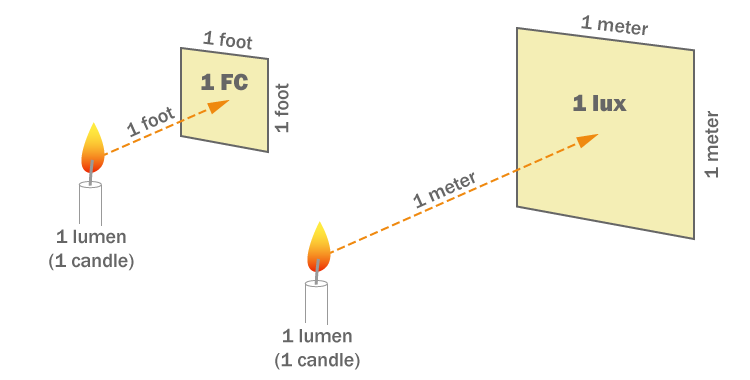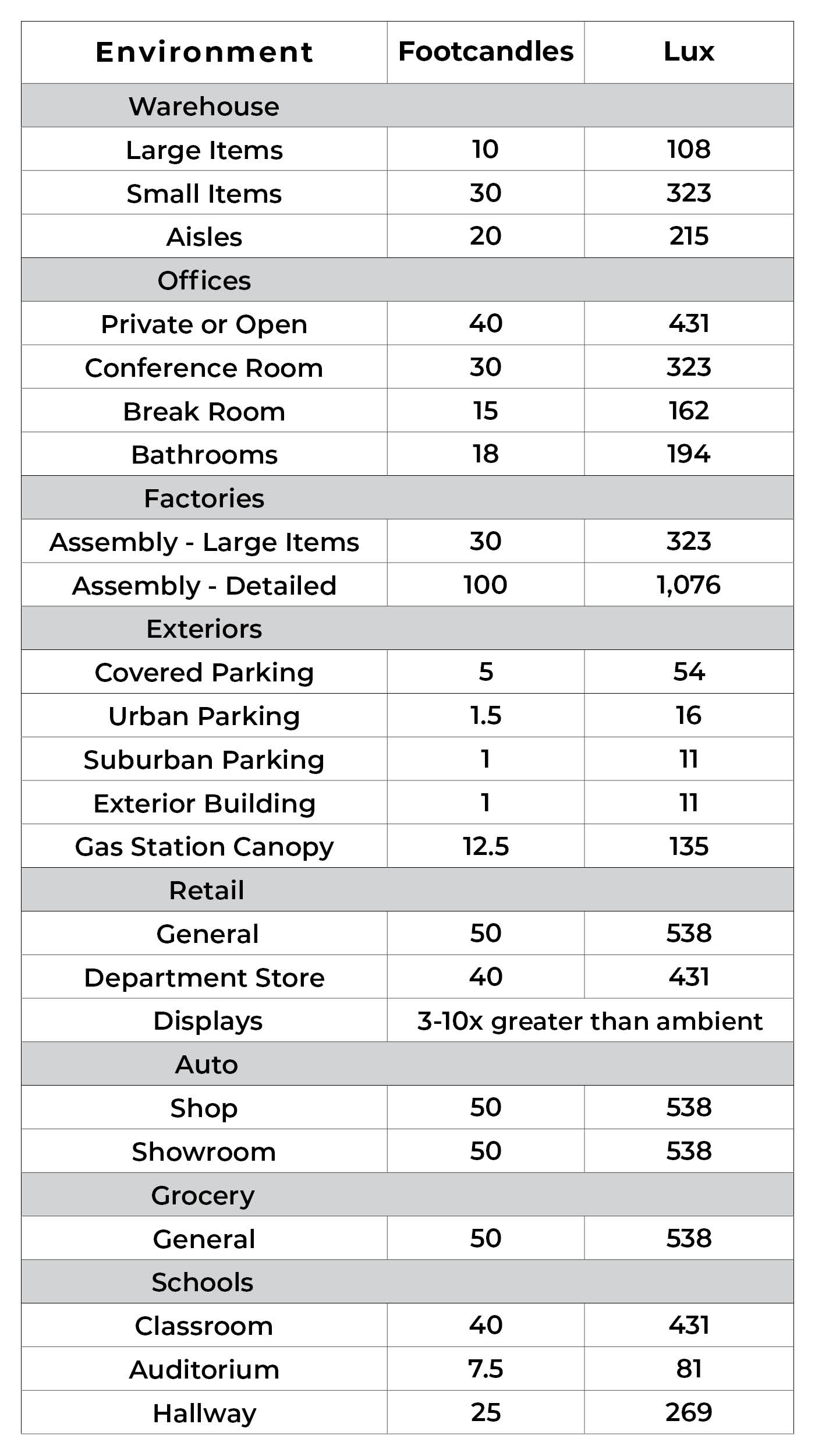Different Areas of a Facility Have Different Lighting Intensity Requirements
According EN 12464 Light and lighting - Lighting of workplaces -Indoor work places the minimum illuminance is 50 lx for walls and 30 lx for ceilings. Local jurisdictions usually require prep areas to be brighter than other areas.

Lighting For Poultry Housing The Poultry Site
The definition of one foot candle is one lumen per square foot.

. Today the light level is more common in the range 500 - 1000 lux - depending on activity. Lobby Area 50 lx 5 fc Waiting Area General 100 lx 10 fc Patient Ward Rooms Observation 300 lx 30 fc Medical Laboratory 500 lx 50 fc Operating Room table 3000 - 10000 lx 300 - 1000 fc Critical Care Areas Examination 500 lx 50 fc Lighting levels have a direct impact on Patient. Different areas of a facility have different lighting intensity requirements.
This allows staff to recognize the condition of food. The required light levels are indicated in a range because different tasks even in the same space require different amounts of light. Please keep in mind that this chart is not comprehensive.
Location Lighting Level. Local jurisdictions usually require prep areas to be brighter than other areas. Lighting thermal comfort working space noise and vibration.
General areas on vessels and vessel sections such as accessways exits gangways stairs and walkways. UK Government had published a document on Lighting at work in 1987. This helps you understand the minimum light intensity of illuminance demanded of a workplace.
An electrical power outage is considered by local regulatory authorities to. The greatest light levels are required by the Food Safety and Inspection Service FSIS which is an arm of the USDA for inspection areas within food processing facilities. 3 An electrical power outage is considered by local regulatory authorities to.
Effects that reduce the individuals ability to perform a task poor lighting distraction. Dining room- 100 lux buffet- 100 lux and kitchen- 500 lux. All lights should have shatter-resistant lightbulbs or protective covers.
Earlier it was common with light levels in the range 100 - 300 lux for normal activities. Light intensity is much higher from the sun than an artificial bulb and overcoming seasonal changes in day length can be difficult. Standard unit of Light intensity is Lux.
3 An electrical power outage is considered by local regulatory authorities to be an imminent health hazard. 2 When mounted on legs stationary equipment must be at least two inches five centimeters off the floor. High light intensity may cause aberrant behaviors such as nervousness feather pulling.
Consider the following when installing and maintaining lighting. 1 Different areas of a facility have different lighting intensity requirements. In general low contrast and detailed tasks require more light while high contrast and less detailed tasks require less light.
This equates to light emitted when one lumen is shone on and evenly distributed across an area of one square foot. Minimum Lighting Intensity Area 50 foot-candles 540 lux Prep areas 20 foot-candles 215 lux Handwashing or dishwashing areas Buffets and salad bars Displays for produce or packaged food Utensil-storage areas Wait stations Restrooms Inside some equipment eg reach-in coolers 10 foot-candles 108 lux Inside walk-in coolers and freezer units Dry-storage areas. All assigned work areas on any vessel or vessel section.
Consider the following when installing and maintaining lighting. To effects that cause dissatisfaction. Lumens foot-candles Area or operation.
The FDAs Good Manufacturing Practices require adequate lighting in all areas of the facility. Activity Quiz 9 Safe Facilities and Pest Management Name Date True or False. Inside all of the facilities mentioned above restrooms and toilets should be illuminated with fixtures capable of 300 lux maintained average illuminance.
Different industries are obliged to satisfy different requirements. Ventilation systems must be. When mounted on legs stationary equipment must be at least two inches five centimeters off the floor.
Construction areas ramps runways corridors offices shops and storage areas shall be lighted to not less than the minimum illumination intensities listed in Table D-3 while any work is in progress. The work environment can impact on a persons performance in a number of different ways from effects that damage health heat stress musculoskeletal disorders. These inspection areas can require 200 foot-candles of shadow-free light with a color rendering index of at least 85.
TABLE F1 TO 191582MINIMUM LIGHTING INTENSITIES IN FOOT-CANDLES. False T or F When mounted on legs stationary equipment must be at. A clear night with the full moon has 1 lux light intensity and direct sunlight has 100000 lux light intensity.
Replace any burned-out bulbs with the correct size light bulbs. Lighting systems in hotels and restaurants may support the following illumination levels. Table 1 below list lighting levels for some areas in a Hospital.
General landside areas such as corridors exits stairs and walkways. 2 When mounted on legs stationary equipment must be at least two inches five centimeters off the floor. Lighting intensityhow bright the lights are in the operationis usually measured in units called foot-candles or lux.
The idea behind lighting is to use variety. Stairs and corridors should support 50 lux lighting levels. Replace burned out bulbs with correct size bulbs.
All lights should have shatter-resistant light bulbs or protective covers. 1 lux is equal to the light intensity of the surface 1 meter away from a single candle. 1 Different areas of a facility have different lighting intensity requirements.
Light intensity will change throughout the day as light will come in from different areas of the house. It is better to have sufficient light at work place. A bright sunny day can be 60000 to 100000 lux.
Lux is a standard unit for light intensity measurement. Different areas of the facility have different lighting intensity requirements. I lux is equal to the light intensity of the surface one meter away from a signal candle.
A combination of direct and indirect lighting task lights in some places and ambient lights in others makes for adequate and conducive lighting in the office. Following is the list of light intensity of different types of lights in our surroundings. The key is to ensure that different kinds of lighting are used depending on the part of the office and the lighting requirements.
Different areas of the facility have different lighting intensity requirements. The 2013 Food Code defines what light intensity to use in various food plant areas including in walk-in refrigeration units food-storage areas and consumer self-service areas above the floor and inside equipment. T or F Different areas of a facility have different lighting intensity requirements.
Different areas of the facility have different lighting intensity requirements. Specification and records of light intensity at critical work areas as identified above. Local jurisdictions usually require prep areas to be brighter than other areas.

Industrial Commercial Recommended Lighting Levels Super Bright Leds Knowledgebase Super Bright Leds Knowledgebase

Recommended Lighting Levels In Buildings Archtoolbox

Industrial Commercial Recommended Lighting Levels Super Bright Leds Knowledgebase Super Bright Leds Knowledgebase
0 Response to "Different Areas of a Facility Have Different Lighting Intensity Requirements"
Post a Comment